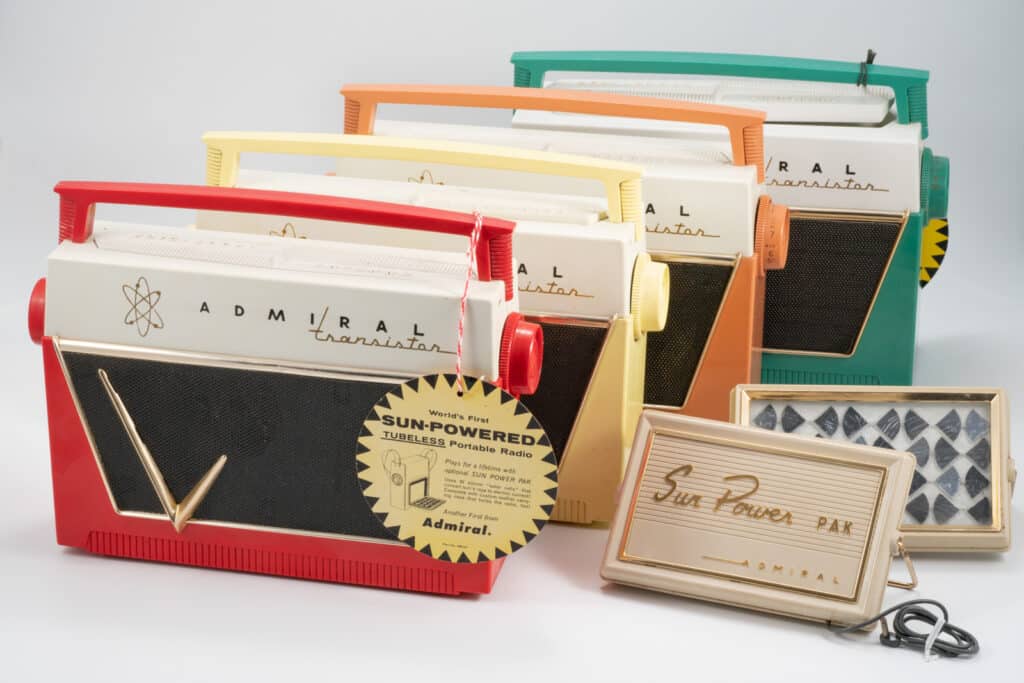
April 25, 1954
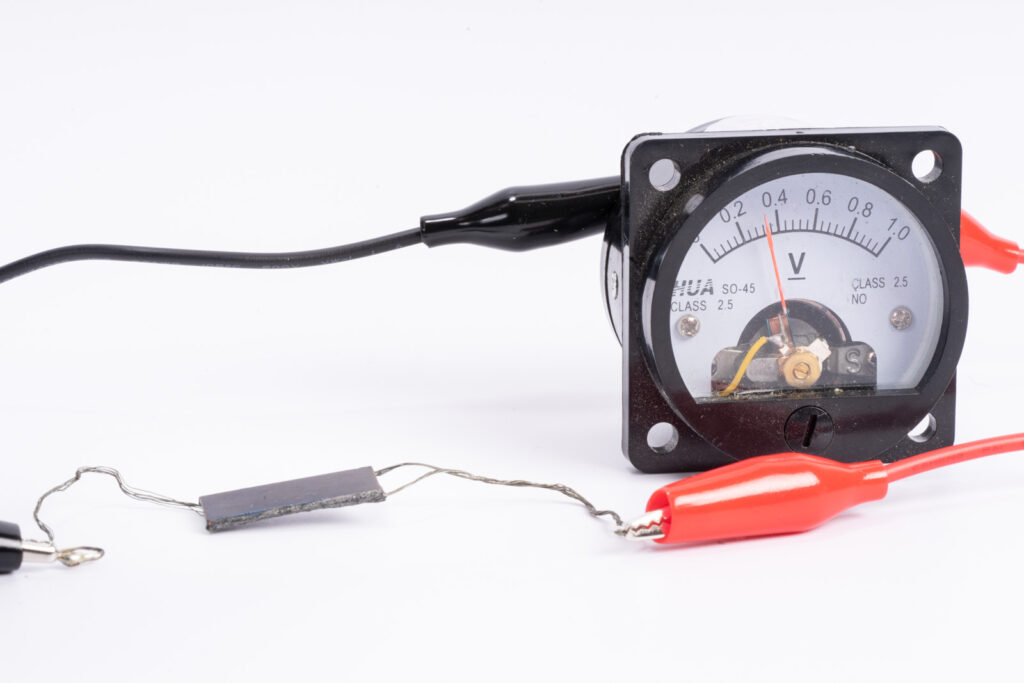
Bell Labratories in New York City announces their invention of the first solar energy battery which can convert the sun’s energy into useful amounts of electricity. The inventors are Gerald Pearson, Calvin Fuller, and Daryl Chapin. Bell Labs is, coincidently, the very place where just seven years earlier (in 1947) other Bell Labs physicists had invented the transistor. This solar energy battery was made of specially treated strips of silicon and the battery (which would come to be known as a “solar cell”) needed nothing but sunlight to produce electrical energy. It had no moving parts; nor was anything in it consumed or destroyed during use. In theory, it could continue to operate indefinitely.
May 20, 1955
The semiconductor division of Chicago-based National Fabricated Products advertises the world’s first commercially manufactured solar cell and begins shipping their half-dollar size cells within a couple of weeks. These cells were somewhat primitive compared to today’s vastly more efficient products and generated less than one-third DC volt per $25 cell. (By the way, that $25 in 1955 dollars would be the equivalent of more than $260 in 2022 dollars). Notwithstanding the price, this offering was well received by scientists and corporations exploring ideas and ways to put this wonderful new technology to practical use.
July 4, 1955
Hoffman Electronics Corporation of Los Angeles announces that it has purchased for an undisclosed amount all of the outstanding shares of National Fabricated Products, and that its founder, Maurice Paradise, would continue as president. Hoffman stated that the only contemplated change at National would be the addition of a department of application engineering. National would continue manufacturing silicon diodes and solar batteries while also working on the development of silicon transistors and power rectifiers. Hoffman at this time was a manufacturer of radios, televisions, phonographs, and special apparatus for the USA Department of Defense.
August 25, 1955
Chicago’s Admiral Corporation engineer Harry Thanos shows a working prototype 6-transistor “Sun Radio” to representatives of the P. R. Mallory Company as they investigate the possibility of Mallory providing component transistors to Admiral. The radio operated from 7 series-wired silicon solar energy cells acquired by Mr.Thanos and Roger Weber from the above mentioned National Fabricated Products. Thus Harry Thanos is credited with having made the very first solar powered radio.
October 21, 1955
Admiral publicly announces this prototype Sun Radio.
October 27, 1955
Admiral demonstrates this prototype solar-powered radio to Chicago Tribune journalists and the Tribune publishes an article with a picture of the radio on page 61 of their October 28th edition.
November 25, 1955
The National Fabricated Products Division of Hoffman Electronics Corp (National still being the sole commercial producer of solar batteries) announces a price reduction of from $25 to $20 for their single-cell type S-1 solar battery and that they would now also market unmounted silicon solar slices in quanity with even further price reductions to permit other companies to develop new applications of solar energy at lower costs and accelerate utilization of solar energy.
January 16, 1956
News release and picture of a General Electric experimental coat-pocket-size solar powered transistor radio put together by engineers Edward Keonjian and James O’Hearn is published in newspapers. Neither this, nor any other GE solar-powered radio was ever put into production.
March 1956
Radio-Electronics Magazine publishes plans for an earphone-only solar powered radio–probably the first instance for an experimenter’s radio project using a photovoltaic cell for power. The actual radio receiver was a simple germanium diode crystal set with a single CK721 transistor serving as the audio amplifier. The power came from a type B-15 self-generating selenium photocell, manufactured by International Rectifier. However, as the cell didn’t put out the required 1.5 volts, it was necessary to cut it into four pieces with a hacksaw and then wire the resulting four smaller cells in series. For times when the sun wasn’t shining, the plans also called for a mercury cell, which could be switched on in place of the solar cell. Attachment to an external aerial was required. Sometime later, this schematic and list of individual essential parts (with prices totaling $13.18) was advertised on page 5 in the Lafayette Radio T4-56 “Transistors” catalog. This do-it-yourself experimenter’s amplified crystal set circuitry was essentially the same as would then be utilized in the 1957 Acopian radio and the several other “kit” solar radio projects during ’57 and the next few years.
April 14, 1956
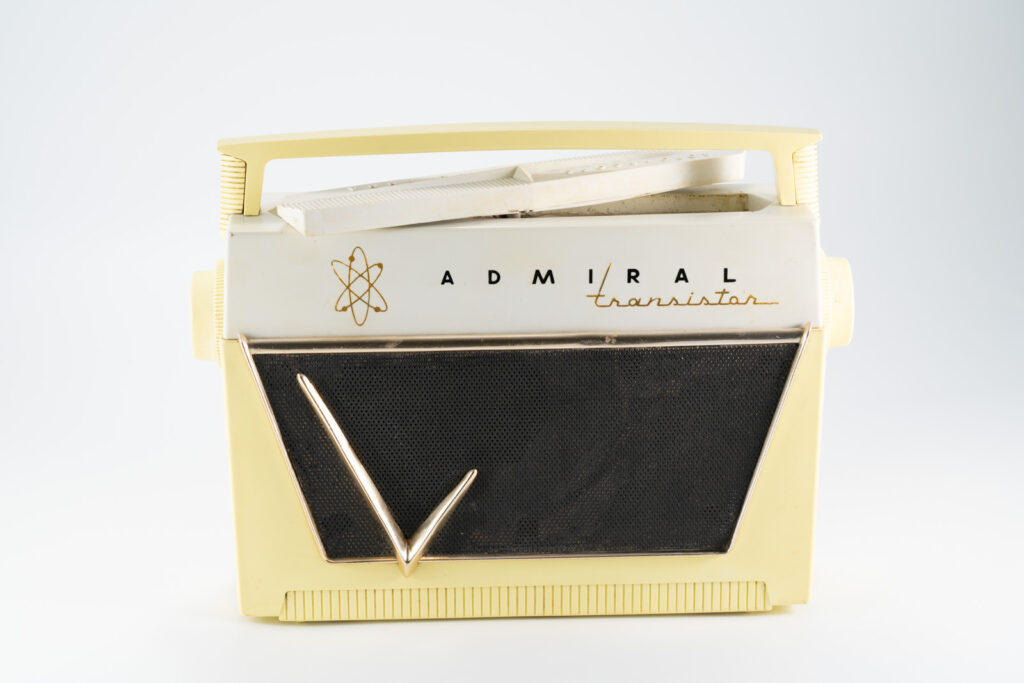
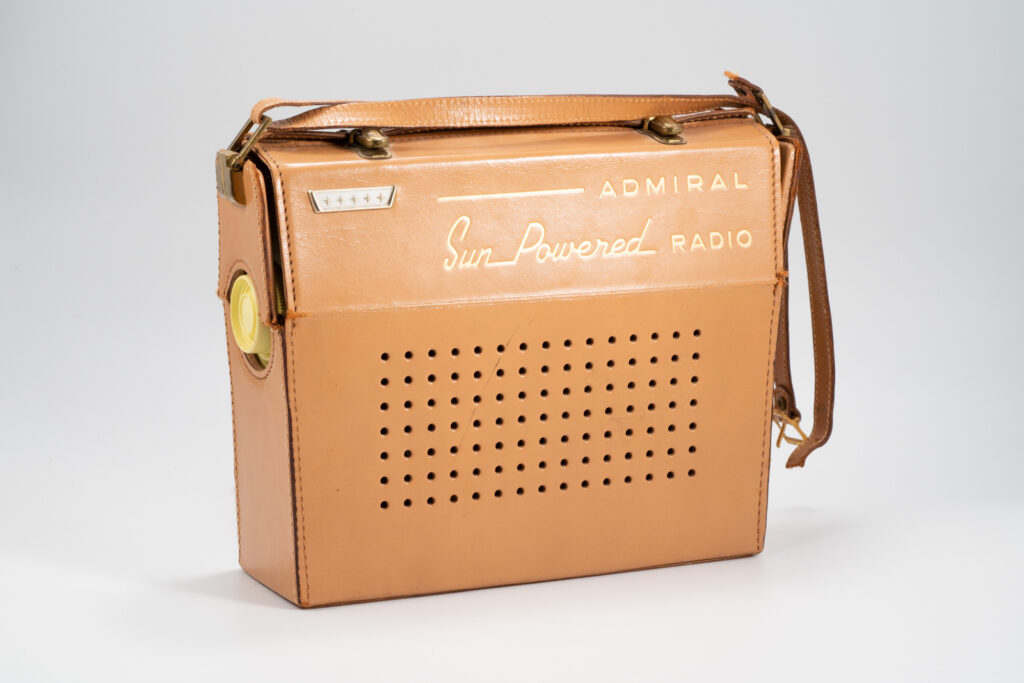
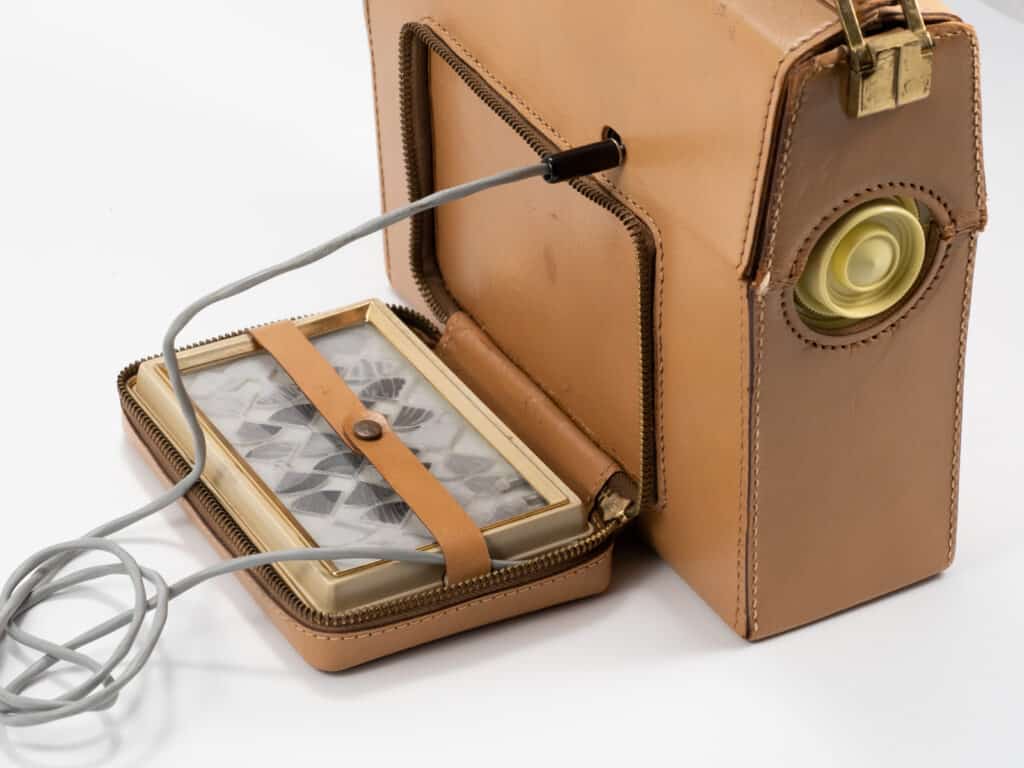
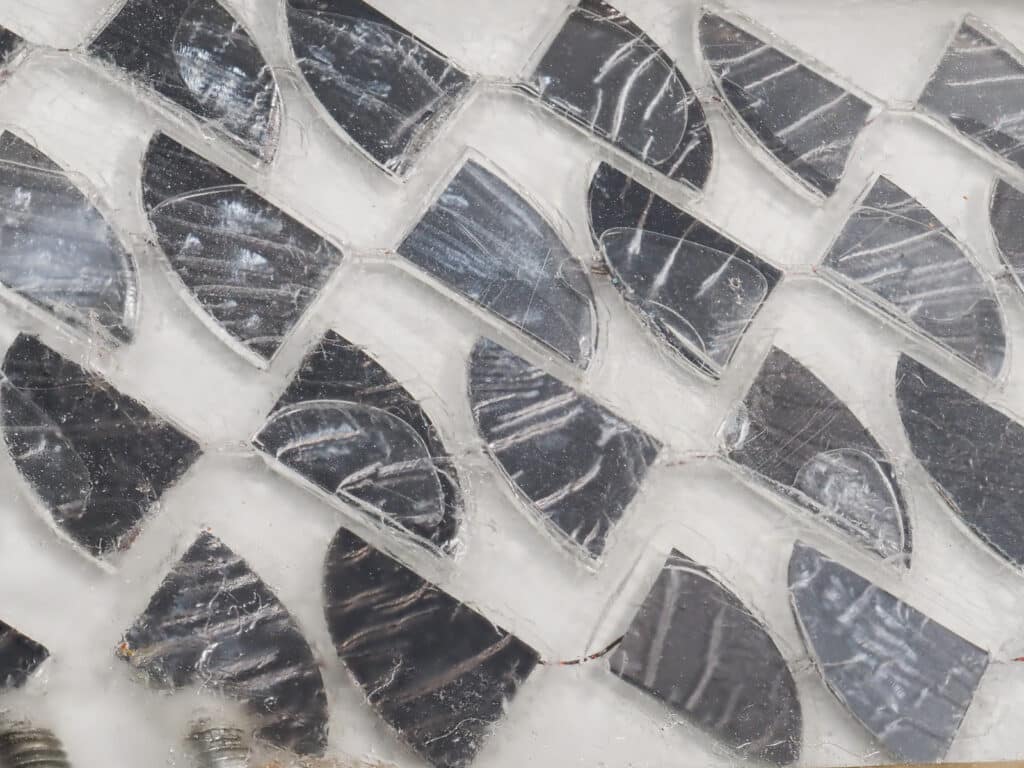
In just a bit less then 6 months after the previous October’s public showing of their prototype solar radio, the Admiral Corporation announces and advertises the WORLD’S FIRST commercially available photovoltaic product – their model 7L series of 6-transistor portable radios; including an optional 32-silicon cell “Sun Power Pak.” Each of the 32 silicon cells was a quarter-pie shape and four of the cells would, if placed right next to each other, be just about the size of a half dollar and so my assumption is that these cut-into-fours solar cell segments were almost certainly made by the Hoffman-owned (as of July 1955) National Fabricated Products. The radio was available in a choice of 4 different cabinet color combinations and was a full size totally portable radio capable of driving a loudspeaker with good volume, sensitivity, and selectivity.
May 10, 1956
At a Dallas luncheon Admiral executives personally deliver to customer #1, Mr. Eugene B. Germany, president of Lone Star Steel Company, the very first solar powered radio purchased. Introductory price for the radio was $59.95 with the “optional” Sun Power Pak costing another $185. A custom leather carrying case with a zippered backside pocket for storing of the Sun Pak was also available for an additional $40.
May 1956 to Fall of 1956
Admiral distributors place examples of the world’s first solar-powered radio in retailer showrooms across the country and place newspaper ads enticing potential customers to come in and see the first solar-powered radio. As displays were necessarily inside stores, the radio could not receive direct sunlight and so the Sun Power Pak would be exposed to an ordinary incandescent light bulb to “power” the solar cells. Consumers marveled at this new technology but sales were poor, likely due to the heavy cost of the optional solar panel, which by this time had been reduced to $175–still nearly $2000 in 2022 dollars. Dealerships were also provided with full color sales literature describing Admiral’s full line of electronic products. In that literature was listed and shown a smaller, coat-pocket size 6-transistor radio (6S series) in the same color combinations as the larger 7L series. The 6S series is shown as using the same optional Sun Power Pak as the 7L. No price was advertised for the smaller solar radio. To date, no examples of this radio have ever been found by collectors and it is believed that none were ever produced or sold. Why Admiral dropped the ball on the pocket size 6S series solar sets after preparing sales literature is a matter for speculation. It could have been due to the poor sales of the 7L series solar radios–or perhaps even due to a change in relationship with their (assumed) solar cell supplier, National Fabricated Products, which was now owned by competitor Hoffman Electronics (and who would in but a few months be announcing the release of their own solar powered radio).
c.1956 – 1957
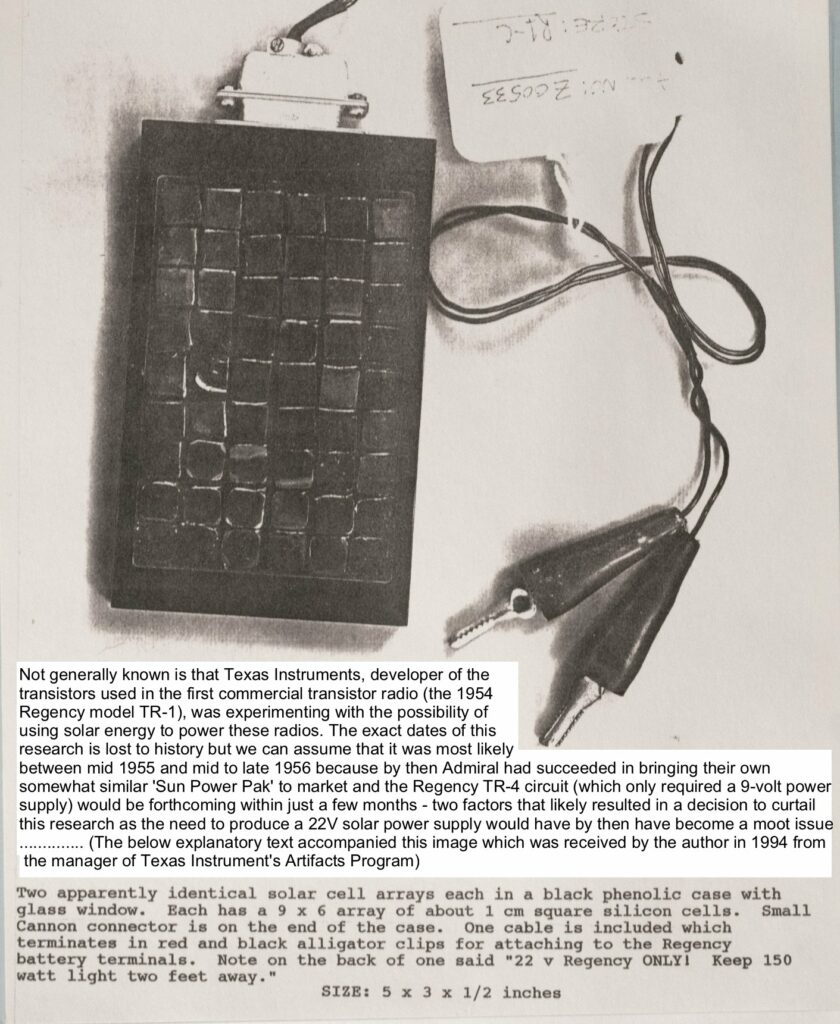
In addition to G.E. having displayed an experimental solar-powered transistor radio in January, at least two other U.S. companies experimented with the idea of powering their transistor radios by solar power. None of the three ever came to market but Magnavox experimented on their AM-2 model and Texas Instruments even built a couple of 22-volt solar panels which could power the Regency TR-1 or TR-1G radios! The Regency solar panels were roughly 3 inches by 5 inches (about the same size as the TR-1 radio).
January 14, 1957
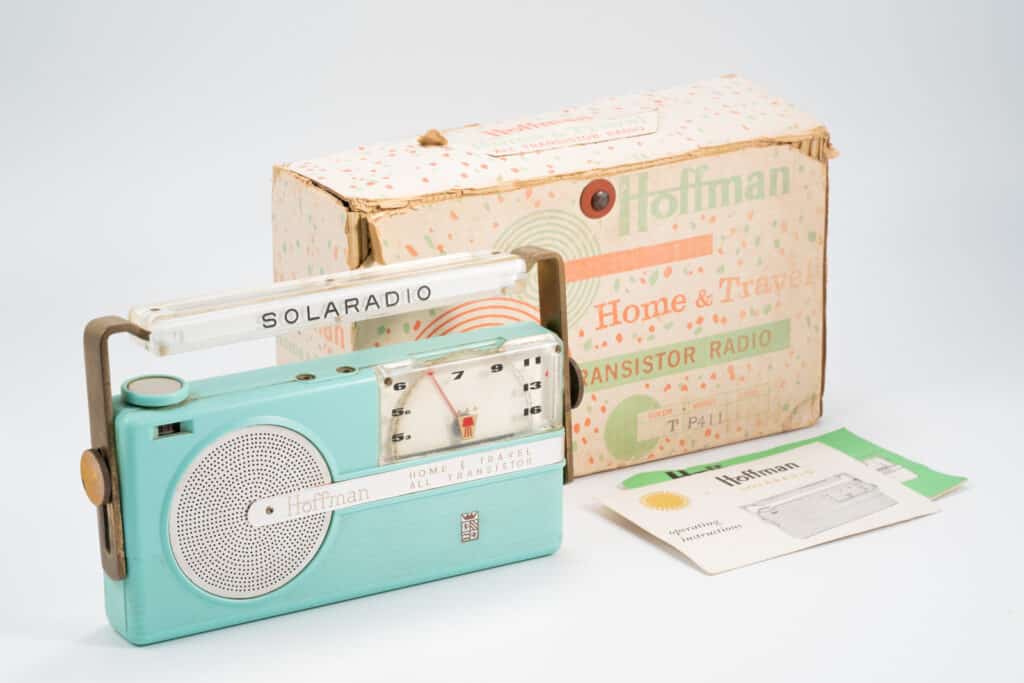
Los Angeles’ Hoffman Radio, a division of Hoffman Electronics Corporation, announces (on page 27 of Los Angeles Mirror News) their Home and Travel All Transistor “SOLARADIO” at a release price of $150 (plus $9 for the four 1-½ volt AA size rechargeable batteries). Hoffman-developed solar cells were contained within the carry handle and would recharge the batteries when exposed to sunlight. This model P-411 series SOLARADIO was available in 5 different cabinet colors and was identical in appearance, except for the handle, to their sister model, the non-solar P-410 Home & Travel Transistor Radio. (The P-410’s handle was a simple rigid-“wire” type handle whereas the P-411 handles incorporating the solar cells were much bulkier.) The non-solar P-410 model also had a far less expensive price tag of $79.95. Both Home & Travel models have an interesting flip-out back stand–a sort of an easel-type stand–on which is engraved the word “Sony.” The cabinets used by Hoffman were virtually identical (except in colors) to cabinets used by the Japanese manufacturer on their 1956 line of model TR-6 radios but at the time Hoffman came out with their “Solaradio” no radios branded Sony had yet been introduced to the American market and so Hoffman had no objection to the basically unknown-in-USA Sony name being affixed to their radios.
April 17, 1957
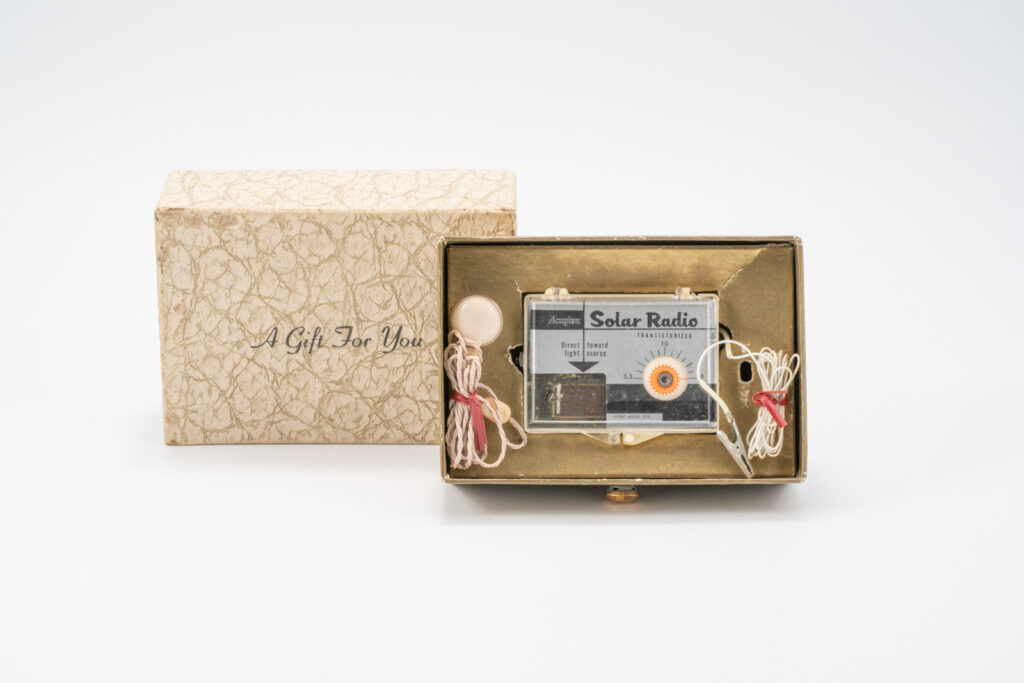
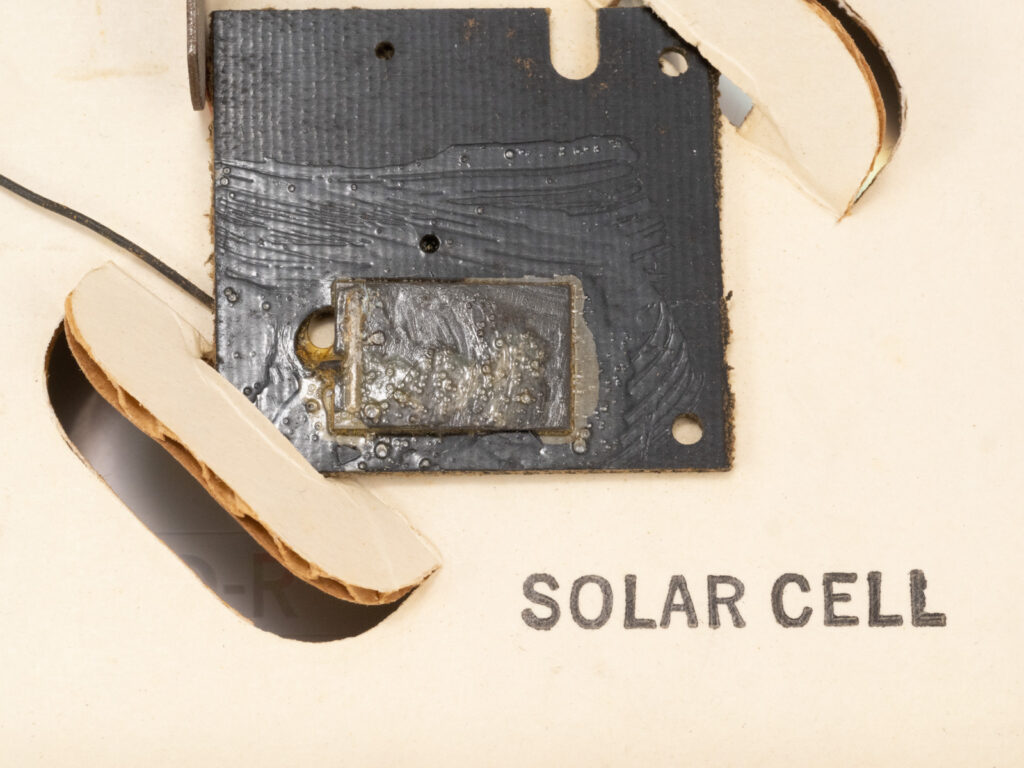
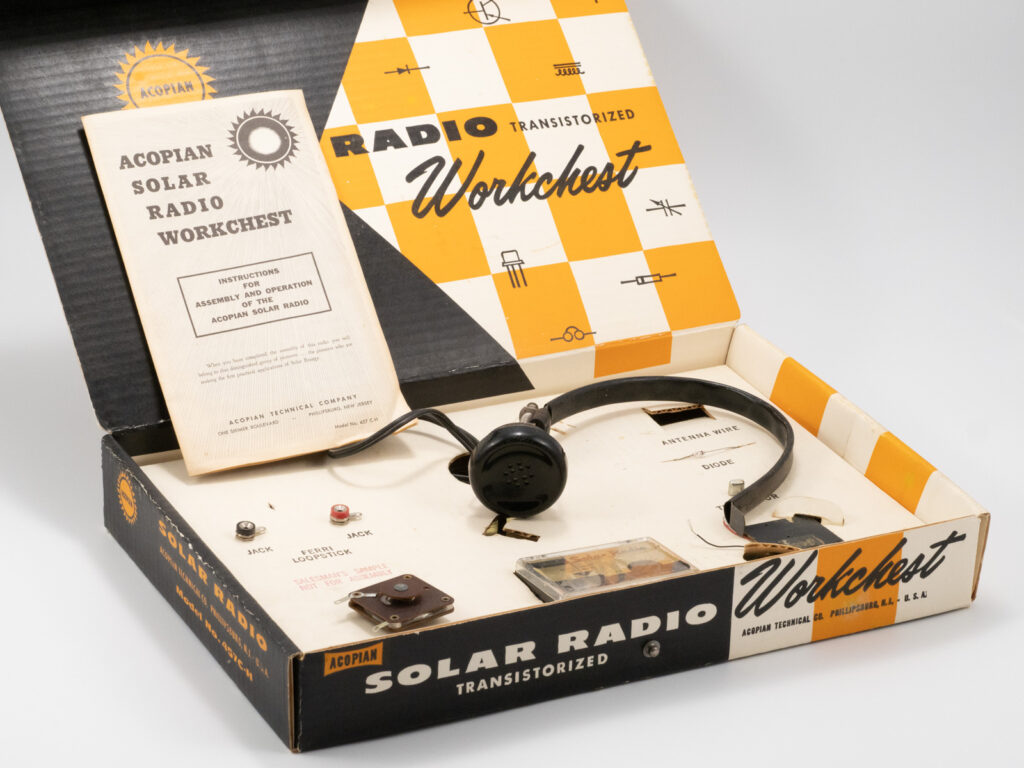
Hess’s Department Store of Allentown PA advertises in a local newpaper the premier availability (at $12.95) of the model 257 P-E Acopian Solar Radio marketed by Acopian Technical Company of Phillipsburg NJ. This was a 3” wide plastic box containing a 1-transistor amplified crystal diode radio feeding an earphone (it lacked enough output power to drive a loudspeaker). The Acopian radio used a single tiny solar cell. An external aerial was required for operation and it came with a clip which could be attached to a long wire or a number of large metal objects which could act as an antenna for the radio. This little radio would also some months later be offered as a “Workchest” kit (model 457 C-H) using a larger headphone and at a slightly lower price. The Acopian also became available late in the year branded as a “Wirco Solar Radio” (model W-5757). Acopians were advertised extensively and at very affordable prices sales were quite brisk. While the actual first production date of an Acopian is not known, I speculate that for model No. 257 P-E (earphone), the “257” could mean Feb ‘57, while the later Workchest kit model might have an Apr ’57 date coded within the 457 C-H (headphone) model number. Unfortunately for historical (in)accuracy, Acopian advertised its radio as the “world’s first solar radio,” even though they were at least one to three or more months behind Hoffman–and nearly a year after THE FIRST commercially available solar-powered radio which was made and marketed by Admiral. Additionally, both the Admiral and Hoffman products were real, full-featured 6-transistor radios that could operate a loudspeaker, and both were completely portable–requiring no additional aerial connections as the Acopian did. The Acopian radio was more of a “toy,” and was considered as such by at least by one public reviewer, whose review called it “not much of a radio for general use.” Nonetheless the Acopian was very affordable and a viable introduction for many to photovoltaic power and, when later in kit form, to electronic experimentation and circuitry. Acopian, incidentally, as of 2022 still maintains a website on which they continue to erroneously claim being first to make a solar radio.
May 26, 1957
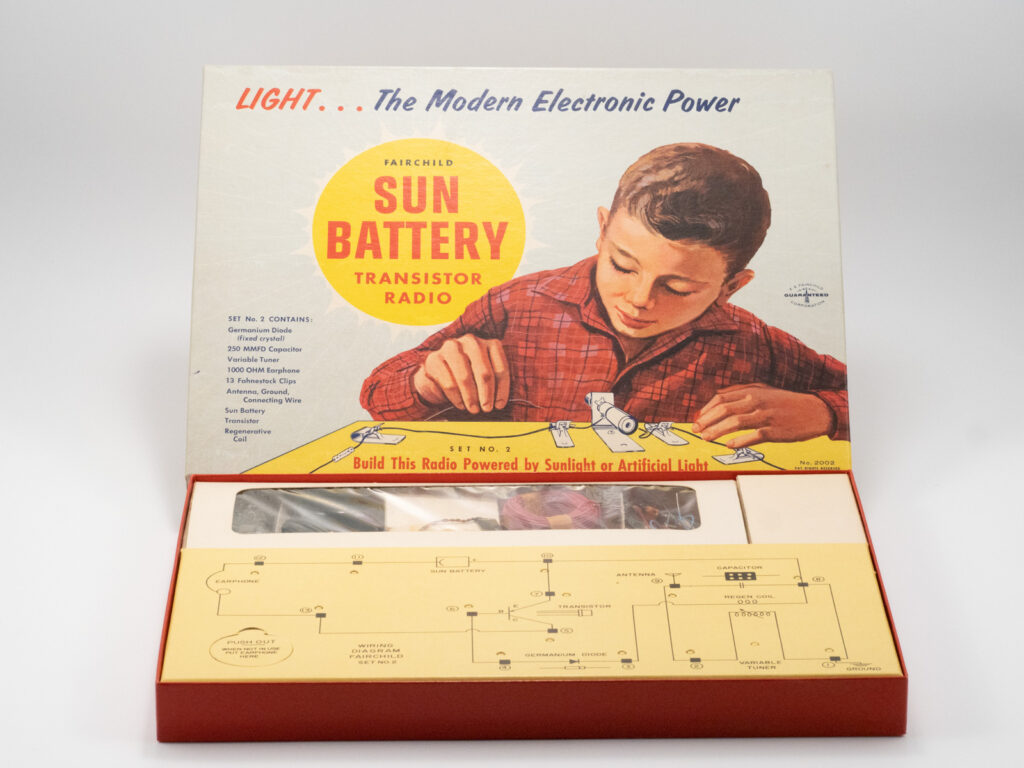
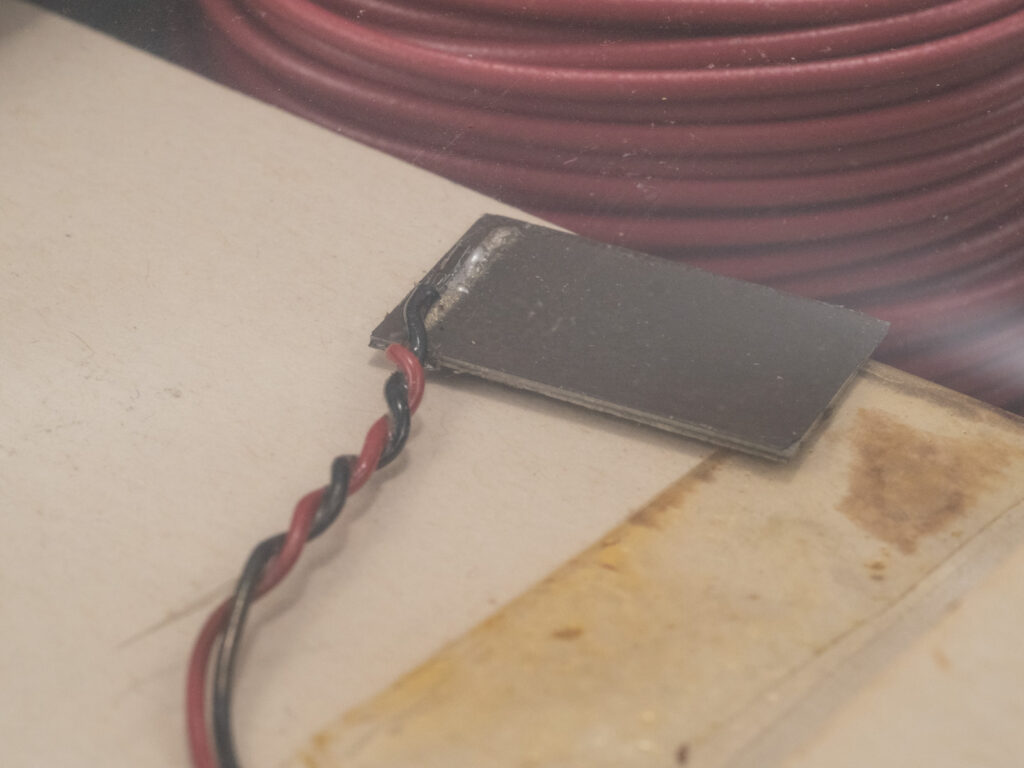
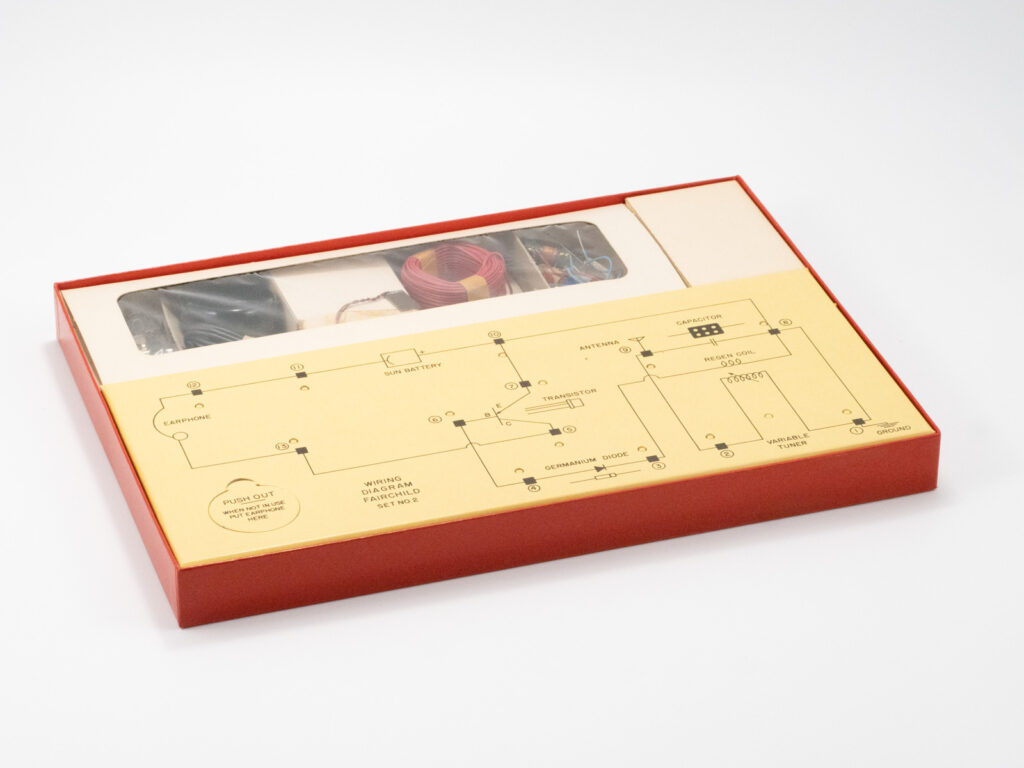
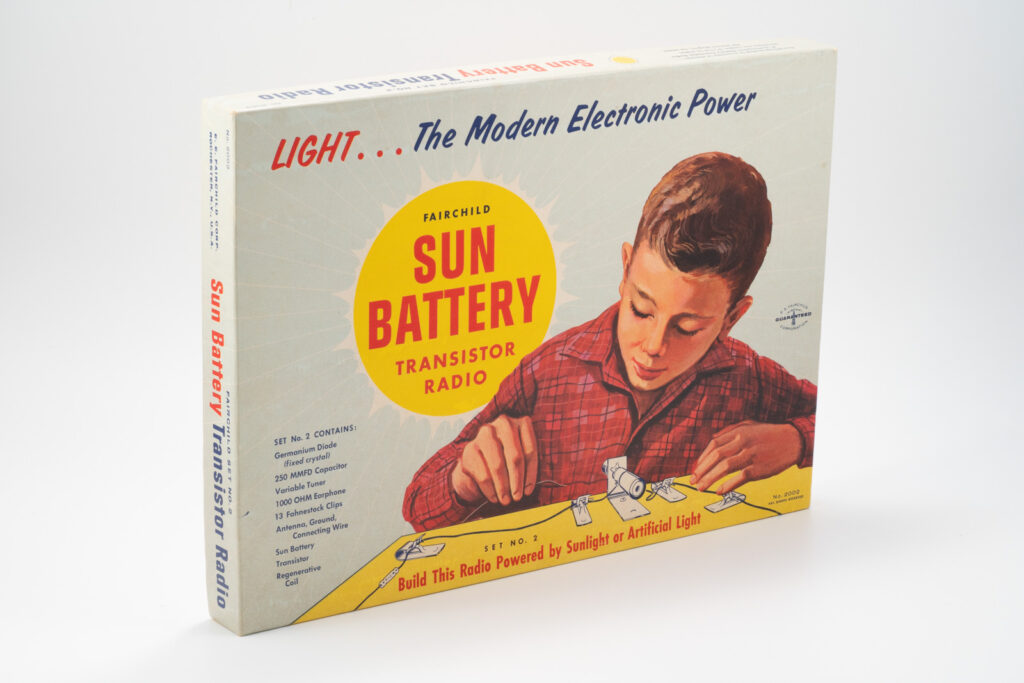
Game and toy manufacturer, E. E. Fairchild was featured on page 16 of the Rochester, NY Democrat & Chronicle in a story about their engineers having developed two (kit) radio sets for children and which were intended to stimulate scientific interest. One was a crystal radio and the other a “Sun Battery” transistor radio. The solar radio kit sold for $8.50 and was an earphone-only regenerative circuit 1-transistor amplified version of the crystal radio.
Late 1957 thru Mid-1960s
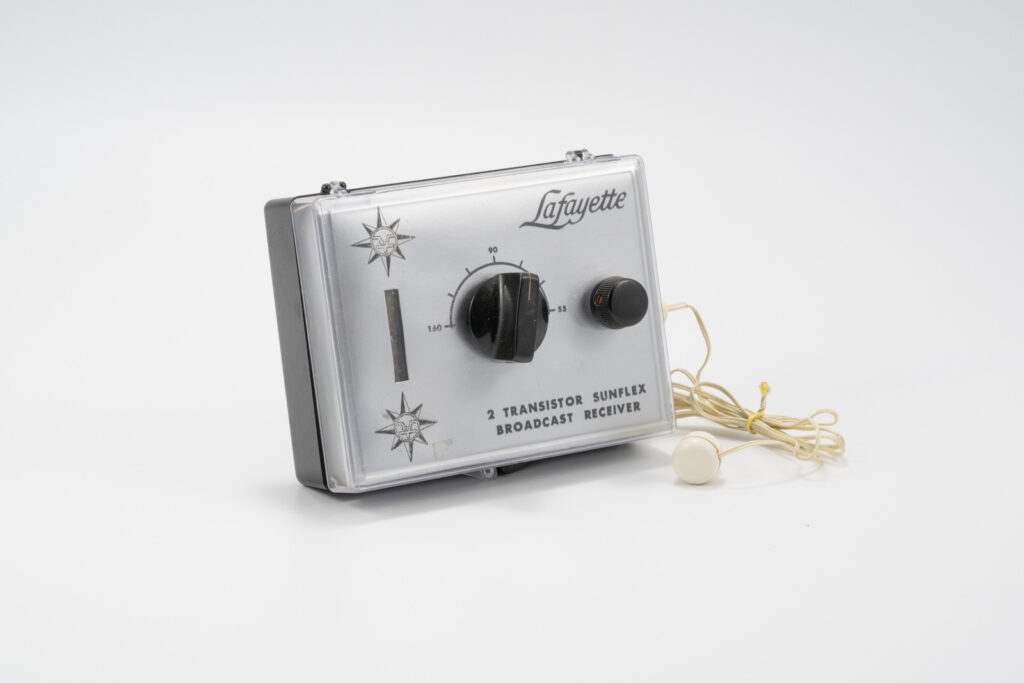
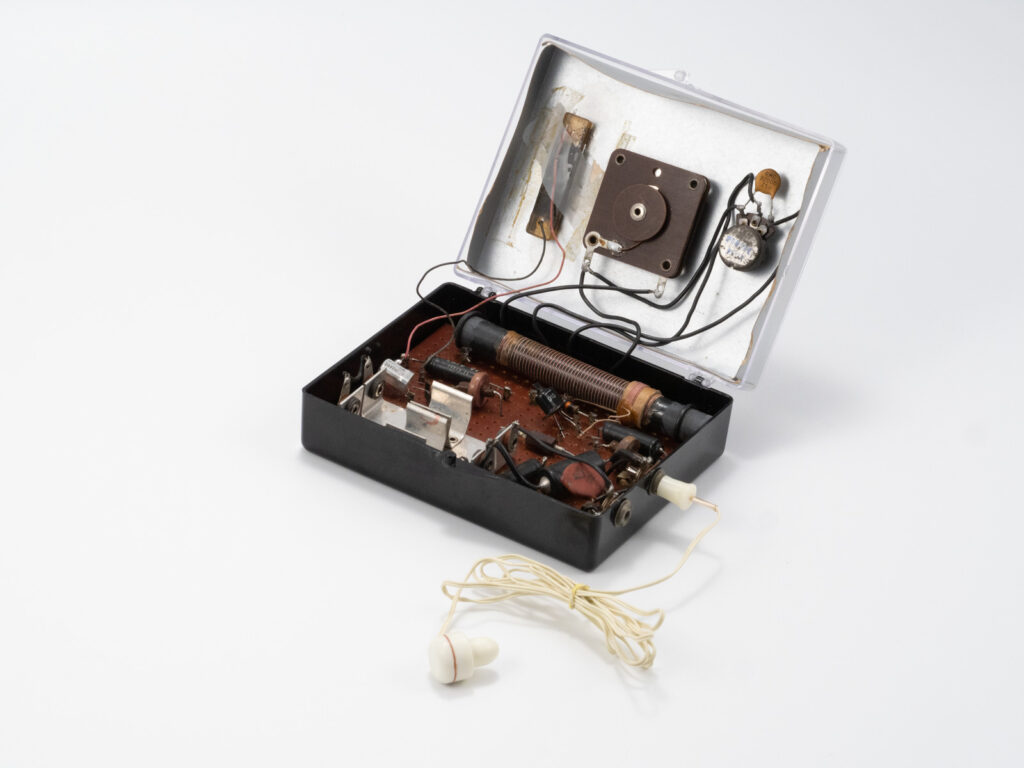
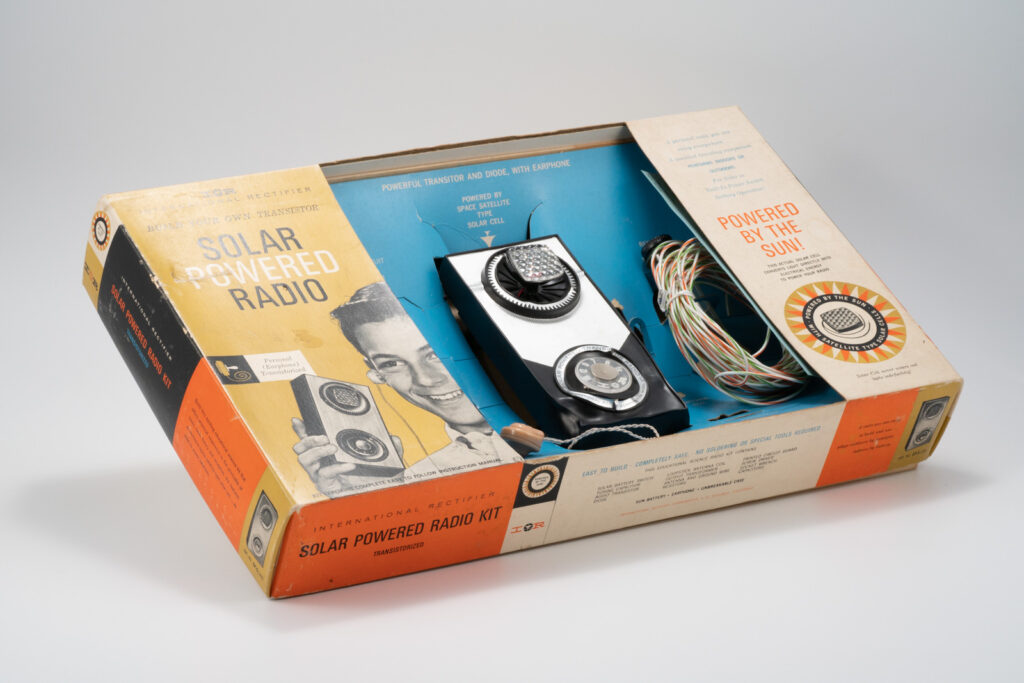
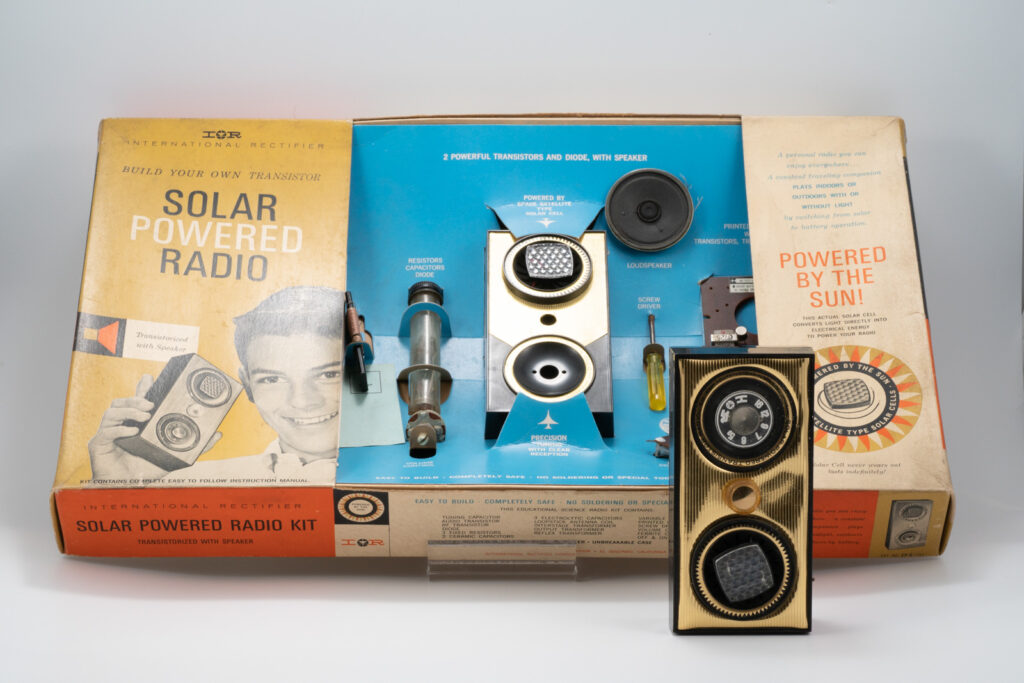
During this timespan several companies offered small kit-built Solar Powered Radios, all but one of which were earphone-only sets. Some were radio-only kits and some included a solar-powered radio as one of several educational or experiment projects. In addition to the Acopian and E. E. Fairchild kits, there were kits available from International Rectifier, Lafayette, Kowa Co., Ltd. (branded as Eleco, Midland, or Philmore), and Science Electronics (whose Erec-Tronics line later became a part of Erector sets manufacturer, A.C. Gilbert). The early 1960’s International Rectifier two-transistor model EP-6 was the only one of these which incorporated a built-in loudspeaker and had the power to drive it. The late 1957 Lafayette model KT-132 “Sunflex” employed a two-transistor reflex circuit which produced the equivalent of a three transistor radio and so, while still only able to power an earphone, it was the first of the D-I-Y solar radios to NOT need an external antenna for reception of local stations.
1958 and on into the mid 1960s
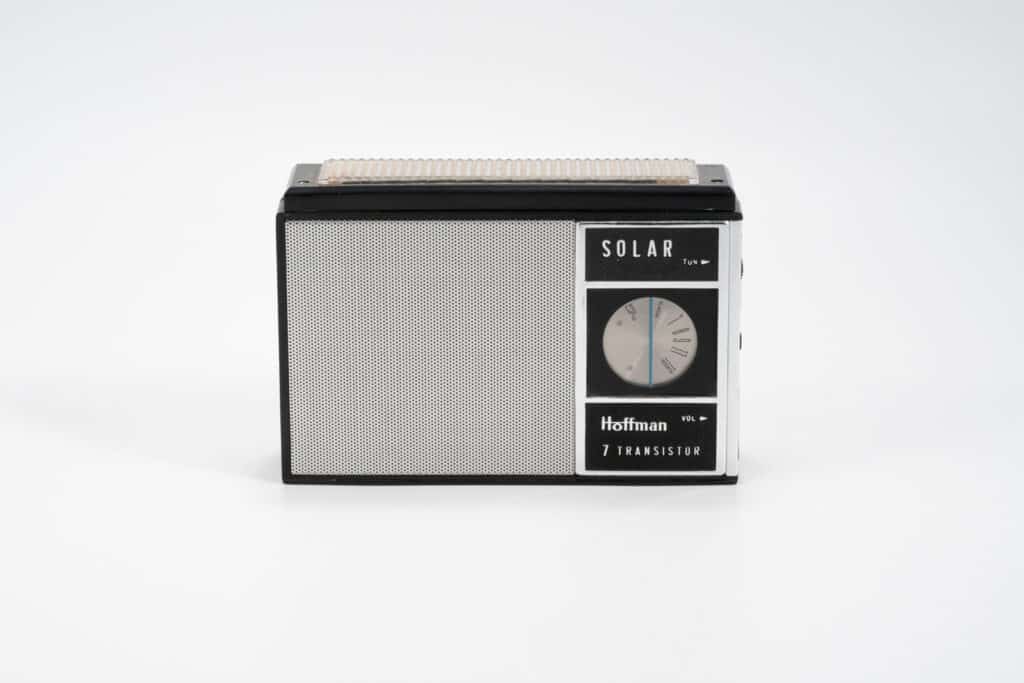
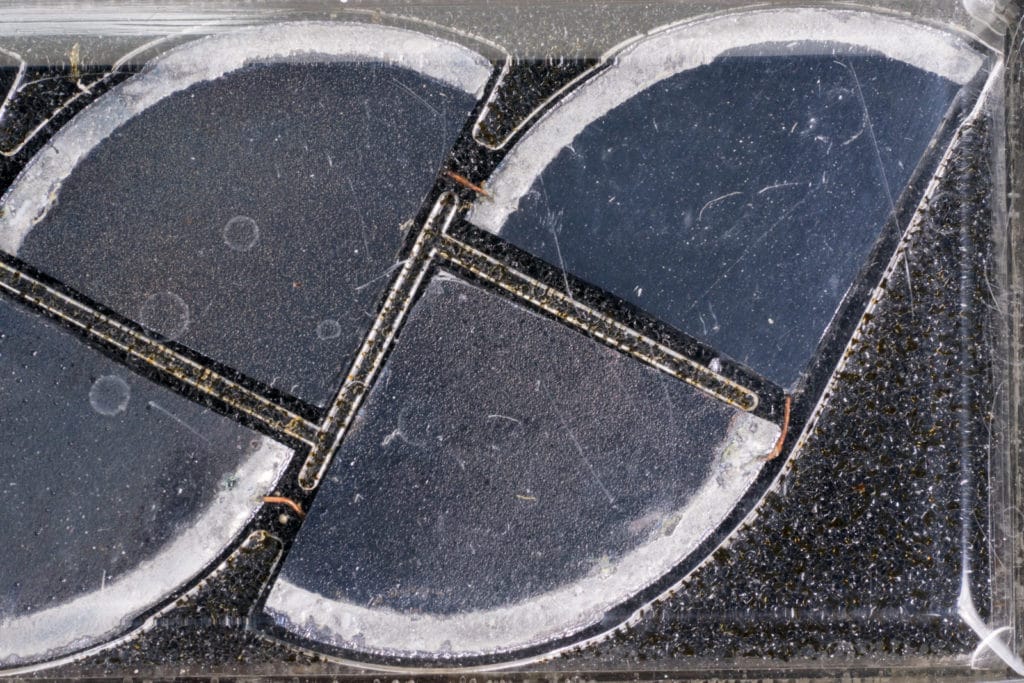
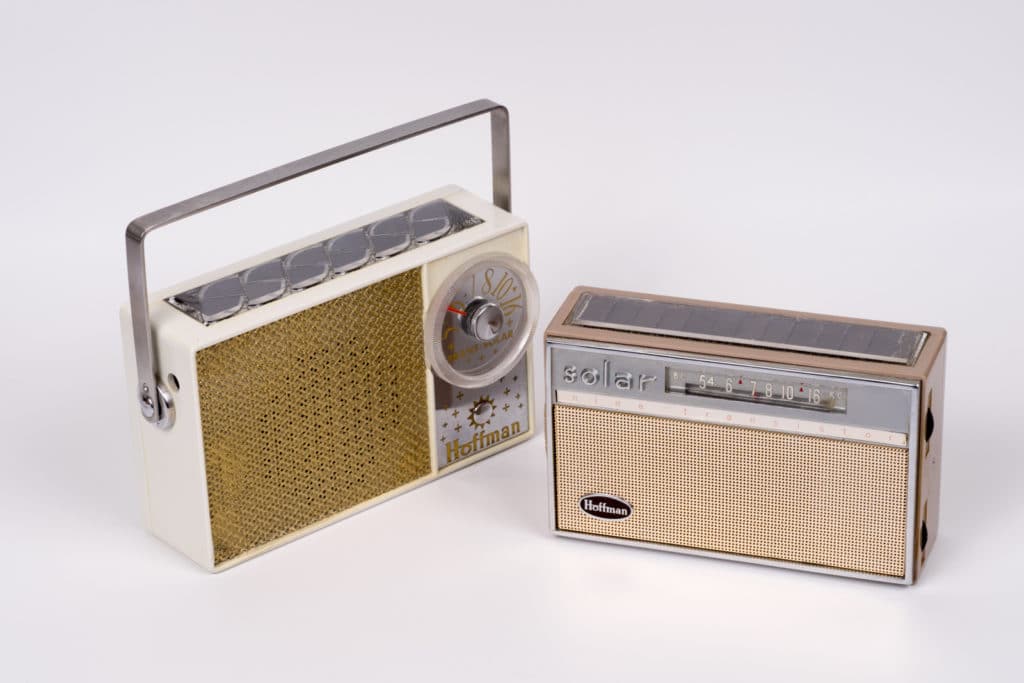
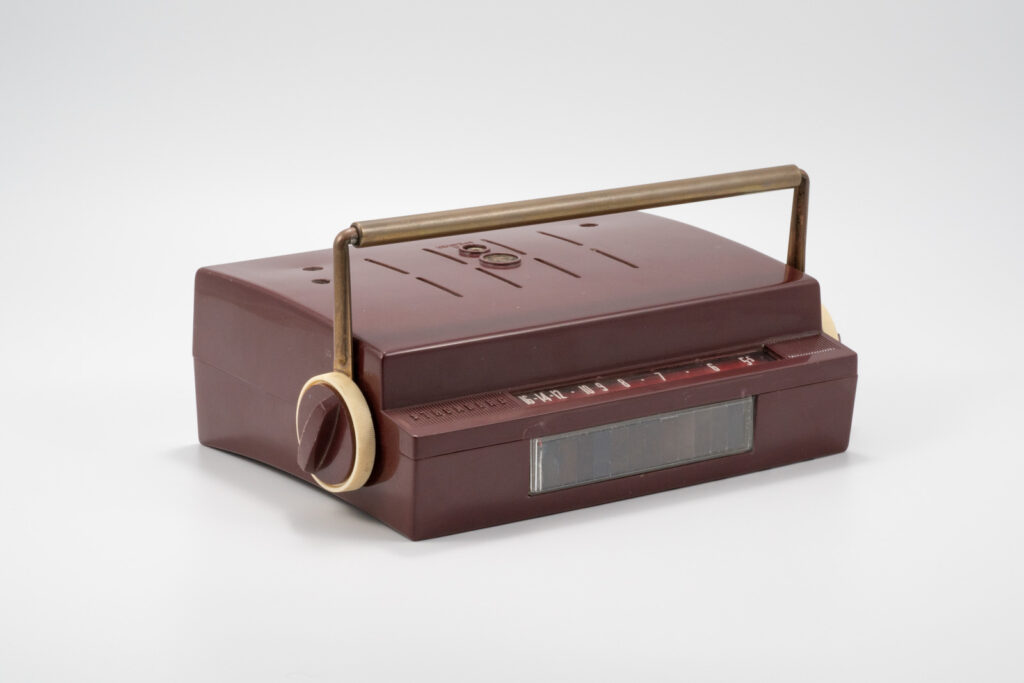
In 1958 Hoffman offered their USA made “Trans-Solar” (model 706) in 7 different cabinet colors and these were followed by two other (Japanese-made) solar-powered Hoffman models (the 9-transistor model 709 and 7 transistor model 719). In these years Hoffman fairly dominated the solar radio market. None of these 2nd or 3rd generation Hoffman radios were designed to re-charge their internal batteries; rather they all operated independently EITHER from solar power or regular batteries. The reasonably priced and great looking/great performing Hoffmans were quite popular and sold very well. Sometime mid-decade Hoffman even offered solar batteries designed to attach to ANY brand of transistor radio employing a 4-1/2, 6 or 9 volt operating circuit. In-the-box were instructions and epoxy mix for (optionally) attaching the solar battery permanently to the host transistor radio — thereby allowing the user to convert their transistor radio to be powered from sunlight. International Rectifier Corp. and Radio Shack also offered similar solar power battery substitutes then or within a couple of years. Meanwhile, Stromberg-Carlson of Australia offered a solar radio in 1960 and Zenith offered their Royal 555 and Royal 56 solar radios in the middle of the decade. The Japanese-made Hoffman 709 and 719’s (also Japanese branded Tokai or Tokyo P-711) and the Australian Stromberg-Carlson model 70T11 “Wayfarer Solarsound” are the only known commercially available non-USA-made solar radios from this early period. The Wayfarer was available either with or without the optional solar panel and its unique design included operating either direct from the top-mounted solar panel (which, by the way, was supplied by and identical to those in the Hoffman 709 models) or as a standard portable transistor radio using internal batteries. In addition, it could become a car radio by sliding it into an optional under-the-dash cradle. When in the cradle the radio would connect to the cars’ outside aerial – although it would continue to be powered by the interior “C” cell batteries. The later Zenith Royal 56 and 555 models operated from “AA” size nickel-cadmium batteries which could be re-charged either from the “Sunray” handle containing “Sun Charger” solar cells, or an adaptor cord plugged into a 110/120V outlet.
Mid-1960s to mid-1980s ….. and way beyond
During the mid ’60s to ’80s period almost NOTHING happened in the solar powered radios arena. Graymark offered a solar radio kit in 1970 and along about 1971 Radio Shack introduced 1-transistor and 2-transistor solar powered KIT radios as well as a couple of solar powered radios included as part of other multi-experiment kits. Following this there seems to have been little other interest in solar radios until the mid 1980s when some small earphone-only solar powered AM only, FM only, or AM/FM stereo sets began coming out of the Far East. Some were “Sun Visor” radios, designed to be worn on one’s head with the solar panel attached to the hat visor, while the majority were little vest-pocket-size sets that might clip onto a pocket or belt. These typically contained hard-wired batteries which would re-charge from front, back, or top mounted solar cells. Some did not display a brand or manufacturer name but radios by Citizen, Kyocera/Souki, Mura, Panasonic, Sanyo, Sun-Mate, Toshiba, and Westminster were among those who advertised their brand in the c.1985-1990 period. Then, once again, production of solar powered radios seems for the most part to have been shelved by manufactures for another 10 to 15 years. In the late-’90s, again from the Far East, sets began appearing with multiple powering choices – including solar power. These evolved into today’s plethora of emergency or general entertainment solar-powered radios which include such additional features as multi AM/FM/SW/Weather Bands, handle-operated cranks to run small generators which charge internal batteries, flashlights, and USB jacks to connect from–or even to power other devices like cell phones. One particularly interesting variation of solar powered radios was/is the somewhat larger South African “Freeplay” AM/FM radios which contain absolutely NO internal batteries. Rather, they are powered by either their solar panel or a wind-up mechanical clock type movement which, as it slowly unwinds, will generate electric energy for the radio. These can also be optionally powered by an external DC power supply.
Timeline PDF
FootNotes
This chronology of early solar radio developments remains a work in progress and may be updated or corrected if or when confirmation of new or additional information becomes available. (Updated March 8, 2023). I assembled this information to share with fellow collectors and persons interested in tech history. You may quote any or all of it if you wish — I ask only that you credit the source; for example: “From ‘Timeline of Early Solar Radios’ by Bill Burkett.” Thank You.
